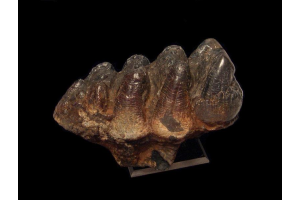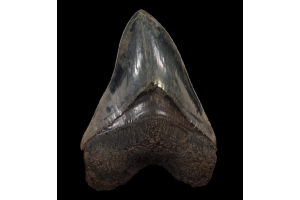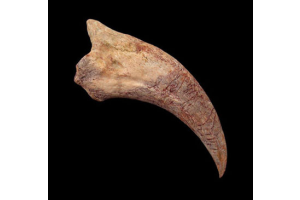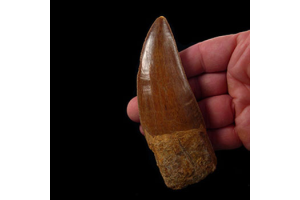Page 7 - Blog
- - August 05, 2025
A five-inch megalodon tooth can change your whole perspective. It has weight, history, and a kind of ancient presence that stops you mid-scroll or mid-conversation. But here’s the thing. Once you’ve held one — held it, traced the serrations, felt the chill of geologic time wrapped in enamel — you begin to wonder what else is out there. Because five inches, while impressive, is far from the full story. In fact, it’s only the beginning.
There’s a tier above impressive. A class of fossils so bold, so oversized, so wildly disproportionate to anything that swims in our oceans today, that even seasoned collectors need to sit down. And somewhere in that elite category, towering above the rest, lives the mythic ruler: the largest megalodon tooth ever discovered.
The Bigger They Were, the Harder They Bit
Let’s rewind about 20 million years. Picture an ocean ruled not by whales or orcas, but by a predator that made both look like snacks. Otodus megalodon wasn’t just another big fish. It was an
- - August 05, 2025
When we examine a Lee Creek Megalodon tooth, our attention is instantly drawn to the incredible patina that covers its surface. This unique combination of hues and textures is one of the most striking aspects of the fossil, and we take pride in offering specimens that tell such an incredible story.
The patina is not simply decorative. It provides valuable insights into the fossilization process and helps us understand the geological environment, the age, and the conditions that led to such remarkable preservation.
A Journey Through Time: The Geological Origins
The Lee Creek phosphate mine in Aurora, North Carolina, has long been a world-famous location for fossilized shark teeth. These fossils are found in two ancient formations:
● The Pungo River Formation dates back to the Miocene epoch, approximately 15 million years ago.
● The Yorktown Formation is from the Pliocene epoch, about 4.5 million years old.
The phosphate-rich sediments of these formations have been ideal for preserving
- - August 05, 2025
If you’ve been browsing fossil forums, scrolling through toothy treasures on niche marketplaces, or whispering excitedly at a fossil fair booth (we’ve all been there), you might’ve noticed something curious. While giant Megalodon teeth still steal the spotlight and the price tags to match, there’s a new obsession quietly taking hold among seasoned fossil collectors: the small ones. And no, this isn’t about settling for less — this is about getting closer to the untold story of a prehistoric giant in a whole new way.
We’re talking about the small Megalodon tooth that’s turning heads and starting hushed conversations between collectors who know a good thing when they see it. So what’s the deal? Why are these petite chompers suddenly the new darling of the Megalodon world? Let’s dig in.
Not Just a Shrunken Giant
At first glance, the fascination might seem puzzling. Megalodon, after all, is synonymous with big — the kind of jaw-dropping size that makes your palm feel insignificant holding
- - August 05, 2025
The world of paleontology has been stirred by a recent revelation in Chile—an extraordinary Megalodon tooth, thought to be among the biggest ever found. This prehistoric relic has sparked passionate debate among scientists, not only for its sheer size but for what it might reveal about the marine giant that once ruled the oceans. While some researchers believe it provides definitive proof of the shark’s maximum size, others caution against drawing conclusions from a single specimen.
Let’s dive into why this discovery has become so controversial—and so captivating.
A Historic Find from Chile’s Coastline
In the rugged terrain along Chile's Pacific coast, a team of geologists and paleontologists unearthed something extraordinary—a massive Megalodon tooth unlike anything they had seen before. The fossil’s sheer length and width suggest it belonged to a creature of truly immense proportions. Although Megalodon teeth have been found around the world, this one stands out for its exceptional dimensions.
- - August 05, 2025
Before museums or coin collections ever existed, ancient humans may have prized something even more captivating—a massive tooth from the king of sharks. These weren’t just fossils; they were symbols of power, mystery, and survival. Today, that same fascination lives on through collectors who cherish each serrated relic. A genuine megalodon tooth fossil isn't just a find—it's a link to a time when giants ruled the sea.
Prehistoric Souvenirs from the Deep
Long before coin hoards, baseball cards, or comic books fascinated collectors, our ancestors might have held on to something just as mesmerizing—giant fossilized teeth from the king of ancient seas: the Megalodon. These massive shark teeth, buried in sediment for millions of years, may have been the first "collectibles" for early humans, not for their monetary value, but as tools, symbols, or talismans.
The idea that a megalodon tooth fossil could hold value across multiple eras bridges an extraordinary connection between ancient civilizations
- - August 05, 2025
What if the key to understanding one of Earth’s most awe-inspiring sea predators was resting in the palm of your hand? That’s the intriguing possibility paleontologists face when they study a big Megalodon tooth. These fossilized remnants are more than just relics—they’re time capsules offering a glimpse into the world of the Megalodon, an enormous prehistoric shark that ruled the oceans millions of years ago. But how can just one tooth reveal so much?
Let’s dive into how researchers use these ancient teeth to piece together the story of the Megalodon’s life, diet, and ultimate extinction—and how you can tell if you're holding the real deal or just a clever imitation.
Why Are Megalodon Teeth So Valuable to Science?
While most of a Megalodon’s body was made of cartilage (which doesn’t fossilize well), its teeth were built to last. These massive, serrated structures are among the only surviving clues to this prehistoric predator’s existence. And because a single Megalodon could shed
- - August 05, 2025
It begins with a single fossil—cold in the hand, serrated at the edge, shaped by time into a symbol of prehistoric dominance. One glance is enough. The texture, the weight, the silent story embedded in its enamel—it captures attention, then obsession. That’s the moment it happens: the realization that this belongs not in a museum, but in your personal collection.
You wouldn’t be the first to feel it. Interest in megalodon shark teeth for sale hasn’t simply risen—it’s surged. Not because a trend told people to care. Because the fossil itself did. Because once someone sees that heart-shaped shard of marine terror, they don’t forget it. It doesn’t politely suggest. It declares, with quiet certainty: I once tore through whales.
That is all it takes. From that moment forward, these teeth vanish from our inventory at a pace that rivals the predator that created them.
The apex predator of apex predators
The Megalodon was not merely large—it was a true apex predator, unparalleled in prehistoric
- - August 05, 2025
When we hold a fossilized tooth from the largest predatory shark ever known, we feel transported to an ancient ocean world. Our work in sourcing West Java Megalodon tooth specimens allows us to bring that history to life for collectors and researchers across the globe.
These fossils, which we recover from limestone deposits in Indonesia, are preserved with exceptional care and continue to hold answers about Earth’s distant past. By making these authentic finds available, we help safeguard an irreplaceable piece of the world’s fossil record.
The Giant That Ruled the Seas
Megalodon, formally known as Otodus megalodon (previously Carcharocles megalodon), was the largest predatory shark ever to exist. This incredible animal is believed to have reached lengths of up to 60 feet, dominating the oceans with its massive presence and unmatched bite force. Living between 23 and 3.6 million years ago, these sharks thrived during the Miocene and Pliocene epochs. Today, their fossilized teeth remain
- - August 05, 2025
We have always been fascinated by Megalodon teeth, and we know collectors share the same excitement. These fossils hold immense historical value and offer a sense of wonder about the prehistoric seas where the mighty Otodus megalodon once ruled. Over the years, popular Megalodon hunting sites like Chile, Peru, Lee Creek, and the Bone Valley mines have slowed down in production, leaving collectors searching for fresh sources.
In May 2020, we were thrilled to introduce top-quality Indonesian Megalodon tooth fossils from West Java, Indonesia. These discoveries have brought renewed excitement as they showcase unique qualities that cannot be found elsewhere.
A Remarkable Discovery from West Java
The Megalodon teeth from West Java are extraordinary fossils unearthed from limestone deposits dating back 10-15 million years during the Middle Miocene period. These fossils, belonging to the extinct Giant White shark, carry traits that make them unforgettable. As traditional fossil sites become less
- - August 05, 2025
At our fossil shop, we often receive questions about the possibility of discovering an 8-inch megalodon tooth. As collectors and enthusiasts ourselves, we understand the excitement behind this inquiry. We have spent years curating and studying Megalodon teeth, and our experience allows us to share valuable insights about the size ranges and rarity of these remarkable fossils.
Using the information we maintain through our catalog and records, we can explain just how rare an 8‑inch Megalodon tooth would be in modern times.
A Glimpse Into the Size Spectrum
Megalodon teeth can vary widely in size, reflecting different stages of the species’ life cycle. According to documented records, these teeth typically range from only a few centimeters up to over 7 inches (17.8 cm) in length. Teeth measuring 2–3 inches often belonged to juveniles, while those between 3–5 inches likely came from maturing sharks.
Larger teeth, measuring 5–7 inches, are considered exceptional and belong to full‑grown







